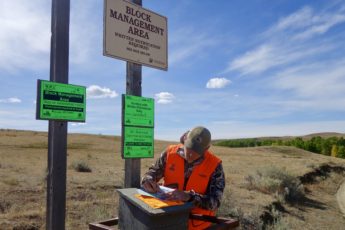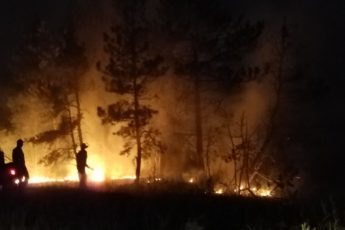A mixing of cultures on the Crow Reservation
For nearly 130 years, Montana’s rich culture has centered around ranching and farming on the state’s vast open spaces. But what about before Montana became a state? Archeological findings prove that humans have populated the area we now know as Montana for at least 13,000 years. For reference, people were living in North America almost 8,000 years before Egyptians constructed the first pyramid. Over the course of those millenia, native tribes each created their own languages, their own diet, and their own way of life. There was just as much cultural diversity between the native tribes in the Americas as there was between countries in Europe.
As a child, I was fortunate to have a view into one of these vast, anciently-rooted cultures. My stepmother, Francine Spang-Willis, a Northern Cheyenne woman from Lame Deer, Montana, wanted to share all that she could with me. She took me to pow wows and got permission from a medicine man to include me in certain ceremonies. She told me stories of her ancestors and how they responded to the U.S. Cavalry that raided their land just 120 years before. She cooked traditional Cheyenne food for me. She brought me along on long drives down dirt roads to places where non-natives are not allowed to go unless they are accompanied by a tribal member.
During that time, I learned much about the Cheyenne ways. But on those drives from our home in Billings to the Northern Cheyenne Reservation, I grew increasingly curious about another reservation we passed through: the Crow Reservation. Francine explained to me that each tribe is different, speaking their own languages and telling their own stories. Although I was raised to be well-versed in Cheyenne life, I knew very little about the Crow culture.
What I did know, is that the U.S. Government took control of the plains, the Crow people chose a very different path than the Cheyenne. While the Cheyenne warred with the U.S. Cavalry, the Crow encouraged their young men to join the U.S. Army as scouts. This strategy carried on for decades and the Crow were assigned the largest reservation of any tribe in Montana.
Curious as to how the mixing of Crow culture and Western culture played out over the last 100 years, I took it upon myself to learn more. My first stop: a white man’s farm located almost exactly in the center of the Crow Reservation.
Business is business, but not before respect
Spencer Kehler’s family has been farming and ranching within the Crow Reservation for three generations. A white farmer, Kehler believes that respecting the Crow culture is key to coexisting with the Crow People.
Spencer Kehler and his son, Justin.
“There’s a lot of animosity due to bad deals made between the Crow and many of the original white farmers and ranchers,” explained Kehler. “I know that some [white ranchers] bought land off of the Crow for quite a bit below what the fair market value would have been. That anger from bad dealings can stick around for generations.”
Kehler explained that much of the Native-owned land on the Crow Reservation is tied up in extensive legal knots. Additionally, once Native Trust land goes through a fee patent process to become private land, it is impossible for it to ever revert back.
As a private landowner, Kehler manages a delicate balancing act. Supporting his family is his top priority, and that means continuing to grow his ranch. At the same time, he puts a premium on respecting his neighbors’ culture.
Kehler told me about several archeological sites on his property, including some suspected burial grounds, which he avoids. He understands that burial grounds were not ever meant as a place to visit.
“[The white people] told the natives to stand here and not to leave. Now, white people live here, they want to develop here, they want to go everywhere,” said Kehler. “These lands are sacred to the Crow. Natives would like to keep a few spots that are really their own. I believe that’s fair. They sacrificed so much, I really just don’t see a problem with it.”
Supporting his family while also showing respect to the Crow People and their land can be a difficult line to ride. But, so far, Kehler seems to be navigating things well. In return, the Crow people have demonstrated their respect for his family.
The Crow tribe adopted Kehler’s daughter, Madison, into the Crow tribe and gave her a Crow name.
“Such an invitation is a gift,” Kehler explained. “It’s very special.”
With some prompting, Kehler eventually agreed to take me on his ATV to see some vision quest sites above his home. His six-year-old son Justin came along for the ride. As we neared the top of a large hill, looming some 600 feet over Kehler’s farm, the father quizzed his son on proper etiquette for visiting vision quest sites.
Justin being careful to not stand on the rocks.
“We don’t move anything,” Justin responded with confidence. “And we don’t ever stand on the rocks.”
As we dismounted the ATV and walked toward a series of rocks placed in the shape of an oval, we discussed how far we could see. The South Hills of Billings sprang up to the North, Bighorn and Pryor Mountains pierced the skyline to the West, and endless rolling prairie stretched as far as the eye could see toward the South and the East. The term Big Sky hardly does this place justice.
“Now you know why they chose to come here,” said Kehler with a proud smile.
Just ask questions
Loren Rausch, a white man from Shepherd, Montana, has been teaching science at Plenty Coups School in Pryor, Montana, within the Crow Reservation, for six years. Though the faculty is roughly half native and half white, all of the students at the school are native. I asked him what advice he would have for non-natives visiting the Crow Reservation.
“Ask all the questions and don’t assume anything,” he told me. “We are in another nation here. How would you act if you were to visit another country? Would you push your own values and act like you know-it-all? Don’t do that here. Pay attention and just ask questions.”
“Just ask questions,” became a popular refrain as I continued my quest.
Having never developed a written language, the Crow People pass down their history through generations of storytelling. These stories have significant importance in the cultural structure of the Crow Tribe. For anyone outside of the tribe to be fortunate enough to hear some of these stories, it’s important to respect the Crow’s right to keep some stories to themselves.
Each tribe is willing to share different information with outsiders. The Crow Tribe is generally regarded as a very open tribe, willing to share stories and information about their culture. But, if you dig enough, you’ll eventually discover that there are certain stories that are not for an outsider’s ears.
Doonie, a Crow woman that lives in Pryor and works at the popular Chief Plenty Coups State Park, appreciates visitors’ curiosity.
“I think all of us [Crow People] understand that there is a major lack of education regarding Montana’s native cultures,” she told me. “I like that people want to learn.”
She went on to explain that when people ask her questions about her culture, it communicates a level of respect.
Crow pride
The Crow culture has gone through a series of turbulent times over the last two centuries. Although they have lost much of their land, they have maintained a strong grip on their culture. A proud nation, the Crow wear their culture with pride.
For visitors to the reservation and third-generation ranchers alike, there’s a clear path to coexistence: respect for the Crow way. Respect through asking questions, respect through accepting the Crow’s right to keep some stories to themselves, and respect through listening. After all, the Crow people have been here 12,500 years longer than any white person. Western culture might have a thing or two to learn from them.
-Written by guest contributor Justin Willis


